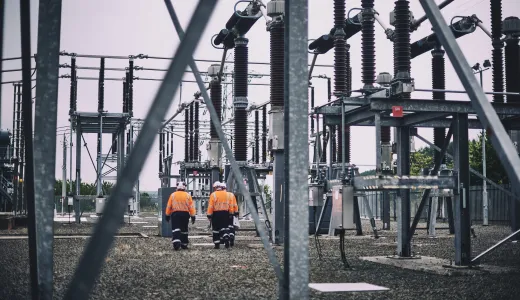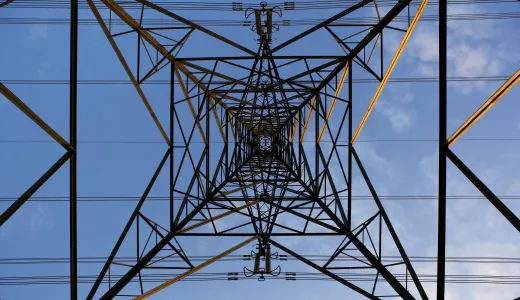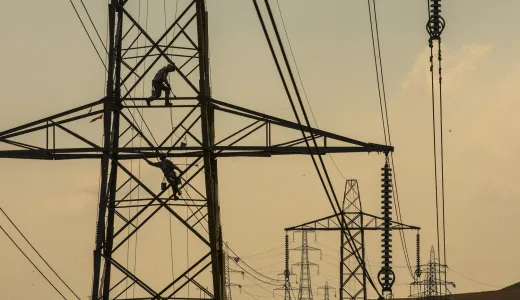What to expect end to end on your connections journey
We collaborate closely with the National Energy System Operator (NESO) that ensures electrical supply meets demand. NESO has the connections contract with you, the customer, and National Grid has a contract with NESO to carry out the work to connect our customers.
Important note:
There is currently a pause in connection applications whilst NESO and Transmission Owners focus their efforts on the efficient implementation of Connections Reform. Therefore, please bear with us while we work on updating our Connections pages to reflect the new connections process.
There are several key points to consider before you submit an application to connect to the high voltage electricity transmission system in England and Wales. These include, but are not limited to:
- Connection type
- Connection size
- Connection date
- Location
- Planning consents
It's also important to be aware of all the relevant grid codes all transmission system connected parties must follow. Visit these links below to understand more:
- Grid Code - Our technical code that our customers must comply with
- Connection and Use of System Code - The contractual framework for connections
- Balancing and Settlement Code - Rules and governance arrangements for electricity balancing and settlement
Research Assistant update notice
As part of our ongoing commitment to providing accurate and relevant information, we have removed the Research Assistant tool from our site.
This decision reflects recent industry changes, including Connections Reform, and the evolving roles of National Grid Electricity Transmission (NGET) and NESO. We are currently reviewing and updating our digital tools to ensure they align with the latest developments and continue to meet the needs of our customers and stakeholders. This review will confirm whether the removal of the Research Assistant is temporary or permanent.
We appreciate your understanding and encourage you to check back soon for updated content. If there’s specific content you’d like us to include in future updates, we’d love to hear from you at [email protected]
Once you’ve researched your connection, and are ready to submit your application, visit the National Energy System Operator portal.
Once NESO has reviewed the application, it will be sent over to us. A specialised team including your dedicated Account Manager, Power System Engineers and Feasibility Engineers, will work with you to design your connection to the network. To do this, they will use industry standards, such as the Security and Quality of Supply Standard (SQSS), to ensure your connection offer is the most economic and efficient solution. Our Power Systems Engineers also undertake computer-based study work to assess the electrical impact of your connection on the network. Your application will follow the below series of studies.
| Thermal studies: Determines power flow requirements | These studies calculate the current flowing through the power system, to ensure our assets have enough capacity to support your connection. All our assets have thermal ratings, so the study will show if an increased power flow due to the new connection remains within the safe rating of that asset. |
| Voltage studies: Determines requirements for any additional reactive compensation devices | Voltage studies may be undertaken to examine any potential voltage instability, voltage control coordination, or to calculate voltage step changes. This will allow us to understand if any new voltage compensation measures alongside your connection may be needed in case of any instability on the network. |
| Fault level studies: Determines required rating of circuit breakers | These studies determine the size of the circuit breakers needed in line with your connection, to preserve the safety of the equipment should a fault occur. To calculate fault currents correctly, we replicate worst case scenarios to ensure the system can handle all fault conditions. |
| Stability studies: Determines any transient stability issues | This assessment looks at the ability of generators to remain stable under normal operating conditions and following a disturbance on the transmission system. |
Once your connection design has been agreed, your Account Manager will collate all the relevant information into a contract which is then sent to the NESO and a connection agreement contract will be sent to you.
The period between NESO sending the connections contract over to us, and us sending it back to NESO during which these processes happen is called a ‘clock start’. See the table below for more information on all the stages of the clock start process.
Key developments that take place after 'clock start'
Setting up your team
We'll put together your NGET core scheme team, which will support you throughout the connection process. This team will be made up of:
- A Power System Engineer - conducts the system studies needed for your connection
- Connection Engineer- puts together a project programme by bringing costs together, whilst verifying how to deliver the works.
- Relationship Manager - your first point of contact for all enquiries relating to NGET. They help manage your needs and requirements.
- Revenue Analyst - Analyses the costs that will be incurred for your connection, to calculate charging elements appropriate and details them in the offer.
- Customer Contract Manager - your NESO Account Manager will remain your primary NESO contact and will be present throughout the connections process.
- The team will kick things off internally by running through your application so that we fully understand all of your connection requirements. If any questions arise these will be raised with you.
Analysing Your Connection Requirements
Next, the system studies are carried out. These studies are conducted based on the data the user provides to us. It may comprise thermal studies, fault level studies, voltage studies and stability studies as outlined in the previous table. The depth of these studies is defined by the data the user provides.
Designing Your Connection
We will then set up an internal offer workshop. This takes into account the study results and determines the best design for your connection. The connection engineer will then develop your solution further, conducting desktop exercises to calculate relevant costs, designs, and programme. We'll contact you to update you with progress made plus initial views of what your offer may look like.
Drawing Up Your Offer
Once this workshop is complete, we will call you to discuss our proposed offer. We will then hold an internal governance meeting, where we will seek approval to release our offer to NESO, on your behalf. Following this, we will produce your Transmission Owner Connection Offer (TOCO), which is then sent to NESO.
Final Amendments
In the final 30 days of the process, NESO will feedback on any amendments of the TOCO. NGET will aim to resolve these as soon as possible. Once this is complete, the user will receive their offer from NESO.
Once you have signed your connection offer, we will, in the appropriate timescales according to your connection date, progress your offer to detailed design.
The detailed design will consider engineering and environmental assessments, as well as discussions around equipment needed.
Regular progress checks will be undertaken to ensure both yourself and NGET are reaching key construction milestones for your project.
Permitted Development Rights
Customers are responsible for securing the appropriate planning consents for customer works, including works which may take place on land owned by NGET. Customers may not rely on NGET’s permitted development rights (which are reserved for the benefit of NGET’s transmission undertaking / NGET operational land) to undertake customer works, and should therefore ensure that they can demonstrate that appropriate consents are in place for all customer works, including on NGET land. Please refer to our Guidance.
Please note: if you are undertaking a User Self Build then you will take responsibility for this step of the connection works. Find out more here.
If at any point during this stage you need to change any project requirements, you must submit a modification application to NESO. This is a formal Connection and Use of System Code to make changes to your existing agreement. This will incur a fee and will follow the same offer process as your original application. A modification application will be submitted via the NESO Connections Portal.
The activities in this stage will be led by our Investment Engineers who may contact you to discuss your connection further and understand site access routes or connection design. The Investment Engineer will also be supported by our Consents team if there are any consenting activities being undertaken by NGET on your project. Your Relationship Manager will also remain a key contact to check on progress against milestones and manage any updates.
During the building process, further surveys and assessments will be done, as well as organisation of contractors and equipment. We will also agree on site responsibilities with you. After this, our construction team will start building your connection in line with your construction programme.
During this stage the construction Project Manager takes over and manages the complete build of the connection - from tender of major items, to managing principal contractors. They will be your main contact in relation to progress at site, coordination of construction activities and commissioning. Connection milestones will also be monitored through regular progress updates with your Relationship Manager alongside your Project Manager.
When your project is ready for construction, you’ll enter the Operational Notification Compliance Process (ONCP), which sets out key requirements for installing and commissioning customer and transmission system assets. This ensures they’re safe to operate, and a certificate is issued to allow energisation.
A joint commissioning panel will be formed to assign responsibilities, including System Assess, transmission system testing, and settlement metering in line with the Balance and Settlement Code. Once commissioning is complete, your new assets will be ready to operate.
For further information, please refer to the NESO page on the full compliance process.
If you are conducting a User Self Build project, the process will differ. Guidance is available here.
When your asset has become operational, you will need to comply with operational Grid Code requirements.
These include coordinated outage planning for work on our transmission assets and providing regular technical data updates. The Transmission Network Control Centre (TNCC) will contact you in relation to outages required on the system.
Throughout the life of your connection, you will pay ongoing use of system costs to the NESO, which covers the costs of maintaining the transmission network and day-to-day costs of balancing the energy system. You may also continue to pay for your connection assets, depending on the payment option you select.
For more information on the Grid code, click here.
During the life of your connection, you might plan to modify or re-plant your connection equipment. The size and nature of this may mean it requires a modification application, which you can submit to the NESO through the NESO Connections Portal.
During this stage, our unlicensed business, Engineering and Consultancy Solutions (ECS) can assist you. Through this part of our business, we provide various additional services, including asset maintenance and refurbishment of customers' equipment, technical support, and consultancy.
When you are ready to end your contract with us, you must give written notice to NESO declaring your intention to terminate.
Please ensure you discuss ending your contract with your Relationship Manager in both NGET and NESO. Once written notice is submitted, the process can begin. Our teams will then work with you to identify if any assets need to be disconnected, and whether you need to reduce your outputs or intakes in advance of your disconnection.
Once this work is finished, you will receive formal confirmation that your contract is terminated, a certificate of disconnection removing you from the balancing mechanism, and a reconciliation of outstanding costs.


